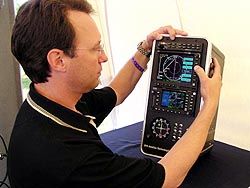 ADS-B deployment will be a massive undertaking, requiring new gear to be installed in ground facilities all over the U.S. But while the FAA is big on sweeping statements about how the government and the successful bidder will create this entirely new way of doing business, its short on detail about a key component of the plan. To work, every airplane using airspace under ADS-B control must be equipped with the avionics that receive and transmit the position data. That gear currently costs thousands of dollars per installation, and so far all that has been offered to mitigate those costs are unverifiable assumptions that the price will drop as demand increases. It also appears that not all airspace will require ADS-B equipage, at least not at first. As AVweb reported last month, the FAA is contemplating what looks like a phase-in of ADS-B, starting with the busiest areas. There has also been discussion that some airspace will be set aside for wind-in-the-hair operations but details have been sketchy. The agencys Joint Resources Council has also determined that the backup system for ADS-B will be 50 percent of the current secondary radar system.
ADS-B deployment will be a massive undertaking, requiring new gear to be installed in ground facilities all over the U.S. But while the FAA is big on sweeping statements about how the government and the successful bidder will create this entirely new way of doing business, its short on detail about a key component of the plan. To work, every airplane using airspace under ADS-B control must be equipped with the avionics that receive and transmit the position data. That gear currently costs thousands of dollars per installation, and so far all that has been offered to mitigate those costs are unverifiable assumptions that the price will drop as demand increases. It also appears that not all airspace will require ADS-B equipage, at least not at first. As AVweb reported last month, the FAA is contemplating what looks like a phase-in of ADS-B, starting with the busiest areas. There has also been discussion that some airspace will be set aside for wind-in-the-hair operations but details have been sketchy. The agencys Joint Resources Council has also determined that the backup system for ADS-B will be 50 percent of the current secondary radar system.
The ADS-B undertaking is so massive that only three companies have been selected to bid on the contract after an initial proposal screening. ITT, Raytheon and Lockheed Martin have been invited to throw their hats in the potentially lucrative ring. With all other things being equal, the inside track would have to be given to Lockheed Martin, which now runs flight services in the U.S. outside of Alaska. The successful bidder for ADS-B will build and maintain the system and the FAA will be its customer, paying subscription charges. The three bidders have been told to finalize their bids in anticipation of negotiations in July that will lead to the award of the contract. In the meantime, the FAA itself is installing the first phase of ADS-B deployment with more coverage on the East Coast, and new coverage in the Southwest, North Dakota and at Philadelphia, Louisville and Juneau airports.


































